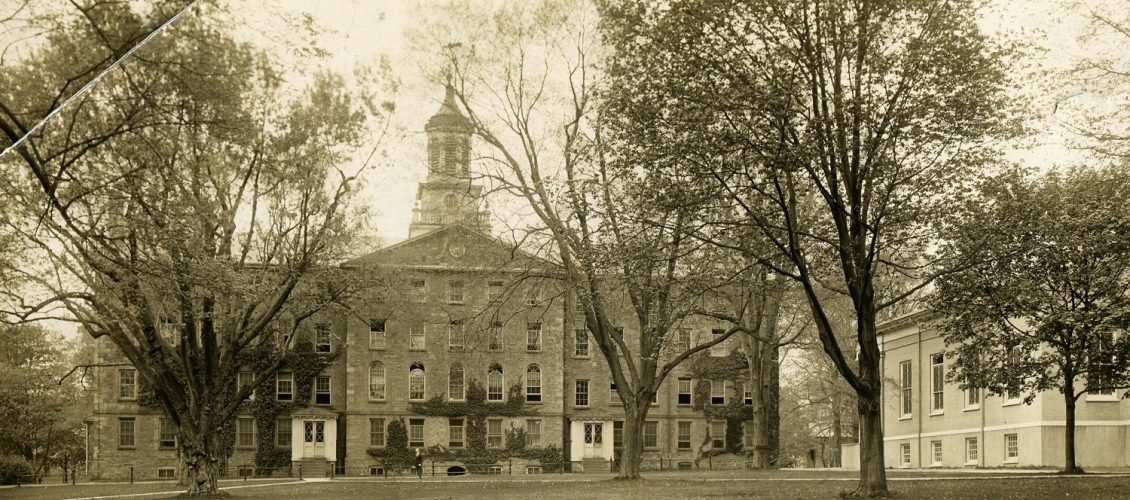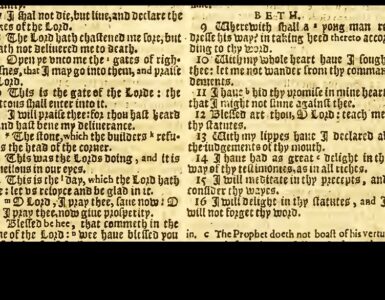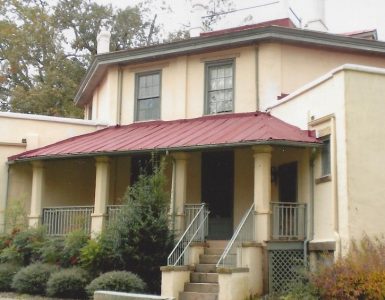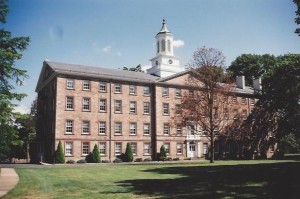 If you have some time while traveling on I-95 between Philadelphia and New York you might want to visit the scenic and important village of Princeton, New Jersey. It is not only a significant location for its part in the American Revolution but is especially important for Presbyterians. Sites to see for church history fans include the campuses of the university and seminary, Nassau Presbyterian Church, and Princeton Cemetery. If you are traveling with your family you could liberate them from the bondage of your Presbyteriana mania to visit the quaint shops, confectioners, and eateries on Nassau Street. The family will appreciate your kindness and you will be free to wander from building to building, reading historical markers, and then walking gingerly through the cemetery as you read the weather-worn inscriptions. Moving from site to site in Princeton involves some walking, but the alternative is parking your car and moving it from lot to lot, which may be difficult when the university and seminary are in session. Depending on how thorough you are in your historical meandering, you could buzz through quickly and hit the main sites, but for a thorough viewing of the locations a leisurely day with a break for lunch would be more beneficial.
If you have some time while traveling on I-95 between Philadelphia and New York you might want to visit the scenic and important village of Princeton, New Jersey. It is not only a significant location for its part in the American Revolution but is especially important for Presbyterians. Sites to see for church history fans include the campuses of the university and seminary, Nassau Presbyterian Church, and Princeton Cemetery. If you are traveling with your family you could liberate them from the bondage of your Presbyteriana mania to visit the quaint shops, confectioners, and eateries on Nassau Street. The family will appreciate your kindness and you will be free to wander from building to building, reading historical markers, and then walking gingerly through the cemetery as you read the weather-worn inscriptions. Moving from site to site in Princeton involves some walking, but the alternative is parking your car and moving it from lot to lot, which may be difficult when the university and seminary are in session. Depending on how thorough you are in your historical meandering, you could buzz through quickly and hit the main sites, but for a thorough viewing of the locations a leisurely day with a break for lunch would be more beneficial.
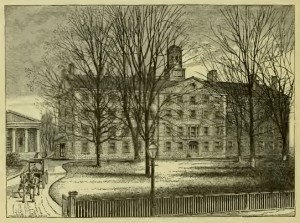 A site to visit is Alexander Hall on the campus of the seminary facing Mercer Street across from the new one-million-volume-capacity library completed in 2013. Alexander Hall is the first building in America built by a Presbyterian denomination for the use of a seminary. Until Alexander Hall was completed seminary classes had been held first in professors’ homes and then later in the public rooms of the college (Alexander, 391). The building had been known simply as “The Seminary” or “The Old Seminary” until it was named Alexander Hall in 1893.
A site to visit is Alexander Hall on the campus of the seminary facing Mercer Street across from the new one-million-volume-capacity library completed in 2013. Alexander Hall is the first building in America built by a Presbyterian denomination for the use of a seminary. Until Alexander Hall was completed seminary classes had been held first in professors’ homes and then later in the public rooms of the college (Alexander, 391). The building had been known simply as “The Seminary” or “The Old Seminary” until it was named Alexander Hall in 1893.
The view of Alexander from Mercer Street presents a beautiful but simple structure that mimics the architecture of Nassau Hall on the university campus. Unfortunately, I could not find my color picture of the front of the building, so I have used a recent view of the back of Alexander photographed from the quad. Princeton had been chosen by the Presbyterian Church for the seminary location at least partially because the college facilities were available for temporary use until the seminary could build a facility. The completion of the construction project not only provided the seminary with its own building, but it also meant that meeting rooms formerly used by the seminary at the college were once again available for college use.
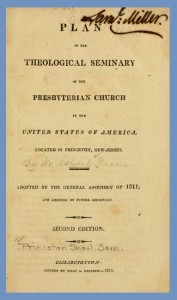 David Calhoun has provided a summary of the dedication of the new building after the corner stone was set in 1815 (1:82-83). The ceremony and dedication began on September 26 just before 5:00 with a procession assembled on the college campus to walk to the special service on the construction site about four blocks away. Leading the group was the college president, Ashbel Green, D.D., who led the professors and students of the seminary; then came the trustees, officers, and students of the college; local ministers and visitors to town were next in procession; and completing the entourage were interested citizens of Princeton. When the stream of people arrived on the construction site the founding professor of the seminary, Archibald Alexander, read the introduction of The Plan of the Seminary. The original plan had been adopted in 1811. Following Alexander’s reading, Ashbel Green stood upon the cornerstone and prayed that the students studying within the new building would teach the gospel of Christ to the nations.
David Calhoun has provided a summary of the dedication of the new building after the corner stone was set in 1815 (1:82-83). The ceremony and dedication began on September 26 just before 5:00 with a procession assembled on the college campus to walk to the special service on the construction site about four blocks away. Leading the group was the college president, Ashbel Green, D.D., who led the professors and students of the seminary; then came the trustees, officers, and students of the college; local ministers and visitors to town were next in procession; and completing the entourage were interested citizens of Princeton. When the stream of people arrived on the construction site the founding professor of the seminary, Archibald Alexander, read the introduction of The Plan of the Seminary. The original plan had been adopted in 1811. Following Alexander’s reading, Ashbel Green stood upon the cornerstone and prayed that the students studying within the new building would teach the gospel of Christ to the nations.
It was appropriate that the procession dedicating the building was led by President Green and that he delivered the dedicatory prayer. It was as if the college was putting its blessing on the seminary, but then in a sense it was, because the college had been established to educate men for the ministry and the seminary had been charged with taking over that responsibility. By the fall of 1817, the seminary began using its fine new building and has continued to do so for one purpose or another ever since. Alexander Hall has suffered boisterous students, fires, long-winded professors, and the storms of wind and winter, but the grand old building stands firm looking to its two-hundredth anniversary in 2017.
A. A. Hodge notes that when his father, Charles Hodge, began his studies in November 1816 the seminary building was under construction. When the building was opened for use in the fall of 1817 only the lower two floors and the oratory had been completed. Charles Hodge was the first student to preach in the oratory of the new building. The oratory was used for chapel services until 1829 when the directors of the seminary raised funds for constructing a dedicated chapel that was completed in 1834.
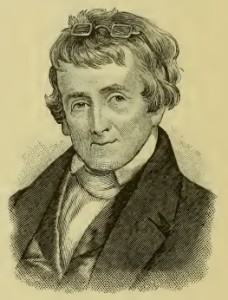 As you view Alexander Hall it should be remembered that during the early years of the seminary it was the seminary building just as Nassau Hall had been the college. The Hodges, Alexanders, Samuel Miller, and other faculty taught a multitude of students in Alexander Hall. The students resided within its walls, used its library, pursued their studies, and ate their meals within their divinity universe contained in Alexander Hall. As the building stands today it has closed its outhouses, added indoor plumbing, installed electrical service and other utilities, and included comforts and conveniences for life in the twenty first century. It has been repainted, repaired, and reroofed with sensitivity to its historic design and purpose.
As you view Alexander Hall it should be remembered that during the early years of the seminary it was the seminary building just as Nassau Hall had been the college. The Hodges, Alexanders, Samuel Miller, and other faculty taught a multitude of students in Alexander Hall. The students resided within its walls, used its library, pursued their studies, and ate their meals within their divinity universe contained in Alexander Hall. As the building stands today it has closed its outhouses, added indoor plumbing, installed electrical service and other utilities, and included comforts and conveniences for life in the twenty first century. It has been repainted, repaired, and reroofed with sensitivity to its historic design and purpose.
While wandering the quad behind Alexander Hall you might notice the coal-black squirrels scampering across the lawn. When I first visited the campus several years ago the bushy tailed and industrious critters caught my attention because the only colors of squirrels I had ever seen were gray and red. The squirrels contribute to the uniqueness of the area behind Alexander Hall and as with many vistas the grounds are especially pleasing in the fall when the leaves turn color and there is a briskness in the air.
Barry Waugh
Sources—The header image is used courtesy of Sandy Finlayson, Director of Library Services, from the J. Gresham Machen collection held by Westminster Theological Seminary. James W. Alexander, The Life of Archibald Alexander, First Professor in the Theological Seminary, Princeton, New Jersey, New York: Charles Scribner, 1854; David B. Calhoun, Princeton Seminary, 2 vols., Carlisle: Banner of Truth, 1994, 1996; and A. A. Hodge, The Life of Charles Hodge D.D. LL.D. Professor in the Theological Seminary, Princeton, N. J., New York: Charles Scribner’s Sons, 1880, 46-47. The color photograph was taken by the author. The portrait of Alexander and sketch of the hall are from Nevin’s Presbyterian Encyclopedia. The copy of the Plan of the Seminary used for this article is the 2nd edition, 1816. Note that there is also an Alexander Hall on the university campus. Information about the new library is available on the PTS website.


